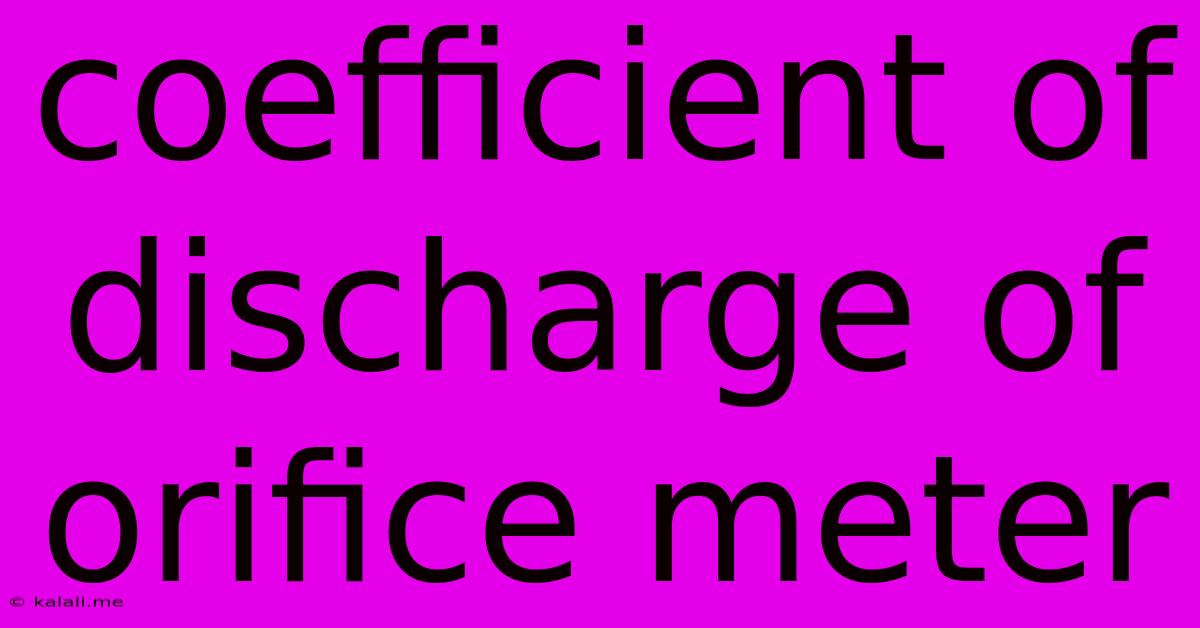Coefficient Of Discharge Of Orifice Meter
Kalali
Jun 11, 2025 · 3 min read

Table of Contents
Understanding the Coefficient of Discharge of an Orifice Meter
The orifice meter is a common flow measurement device used in various industries to determine the rate of fluid flow through a pipe. Its simplicity and relatively low cost make it a popular choice, but accurate measurement depends heavily on understanding the coefficient of discharge, often denoted as Cd. This article will delve into the intricacies of the coefficient of discharge, explaining its significance and factors affecting its value.
The coefficient of discharge essentially represents the efficiency of the orifice meter in converting the pressure differential into a flow rate. It accounts for the inevitable energy losses that occur as the fluid flows through the restriction created by the orifice plate. A higher Cd indicates a more efficient meter, with less energy loss translating into a more accurate flow measurement. Understanding this crucial parameter is vital for accurate flow calculations.
What is the Coefficient of Discharge (Cd)?
The coefficient of discharge is a dimensionless factor that accounts for the irreversible losses of energy that occur during the flow through the orifice. These losses are primarily due to:
- Friction: The fluid experiences friction as it flows through the orifice, causing a reduction in its kinetic energy.
- Contraction and Expansion: The fluid stream contracts after passing through the orifice before expanding again to fill the pipe. This process leads to energy losses due to turbulence and vortex formation.
- Velocity Profile: The velocity profile of the fluid is not uniform across the pipe's cross-section, leading to further energy losses.
The coefficient of discharge is typically determined experimentally and is usually less than 1. A Cd of 1 would indicate a perfectly efficient system with no energy losses, which is practically unattainable. The actual value of Cd depends on several factors, which we'll explore in detail below.
Factors Affecting the Coefficient of Discharge
Several factors influence the value of the coefficient of discharge for an orifice meter. These include:
-
Reynolds Number (Re): The Reynolds number characterizes the flow regime (laminar or turbulent). The Cd varies with Re, particularly in the transitional flow regime. At very high Reynolds numbers, the Cd tends to become more stable.
-
Beta Ratio (β): This ratio represents the diameter of the orifice to the internal diameter of the pipe (β = d/D). The Cd is significantly affected by β, typically ranging from 0.2 to 0.75. Values outside this range might lead to inaccurate measurements.
-
Fluid Properties: The viscosity and density of the fluid influence the energy losses and consequently the Cd. Higher viscosity fluids tend to have lower Cd values due to increased frictional losses.
-
Orifice Plate Geometry: The sharpness of the orifice edges, the surface finish, and the presence of any imperfections on the orifice plate can affect the Cd. Precise manufacturing is crucial for achieving consistent and accurate measurements.
-
Upstream and Downstream Piping: The configuration of the piping system upstream and downstream of the orifice plate can influence the flow pattern and hence the Cd. Straight pipe sections of sufficient length are essential before and after the orifice to minimize disturbances.
Determining the Coefficient of Discharge
While a theoretical calculation is possible, accurately determining the Cd often requires experimental methods. Calibration against a known flow standard is the most reliable approach. Empirical correlations and equations based on extensive experimental data are also available, enabling engineers to estimate the Cd based on the factors discussed above. These correlations are often presented in the form of charts or graphs which provide Cd values for various combinations of β and Re.
Conclusion
The coefficient of discharge is a critical parameter in orifice meter calculations. Accurately determining or estimating its value is essential for precise flow measurement. By understanding the factors that influence the Cd and employing appropriate methodologies for its determination, engineers can ensure the reliable and accurate performance of orifice meters in various industrial applications. Ignoring the impact of the Cd can lead to significant errors in flow rate calculations, affecting process control and potentially causing safety concerns. Therefore, a thorough understanding of its significance remains paramount.
Latest Posts
Latest Posts
-
Difference Between Yield And Interest Rate
Jun 12, 2025
-
A Model Created By Biologist Luis
Jun 12, 2025
-
What Body Of Water Separates Australia And New Zealand
Jun 12, 2025
-
Which Of The Following Disasters Has A Slow Onset
Jun 12, 2025
-
Max Moment For Simply Supported Beam
Jun 12, 2025
Related Post
Thank you for visiting our website which covers about Coefficient Of Discharge Of Orifice Meter . We hope the information provided has been useful to you. Feel free to contact us if you have any questions or need further assistance. See you next time and don't miss to bookmark.